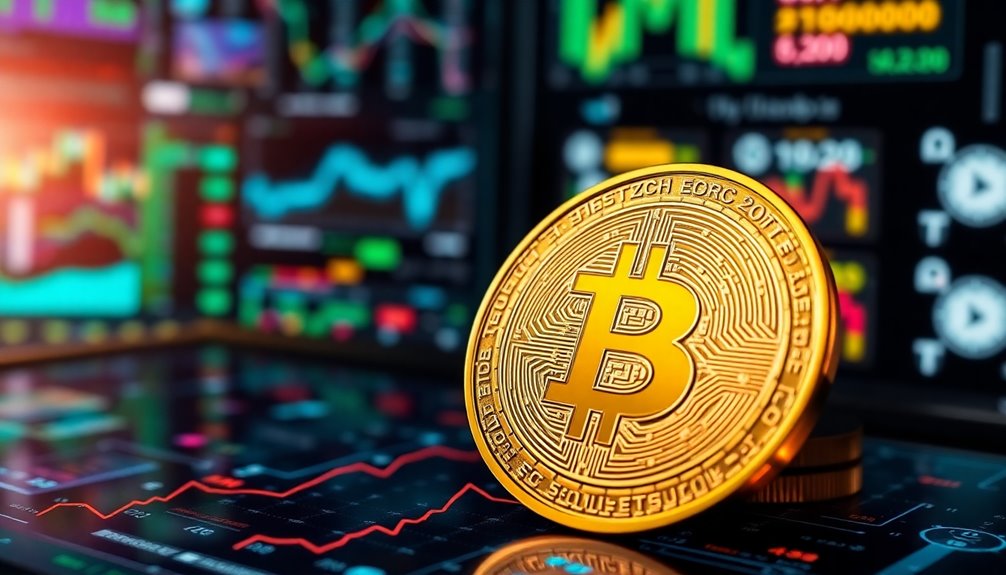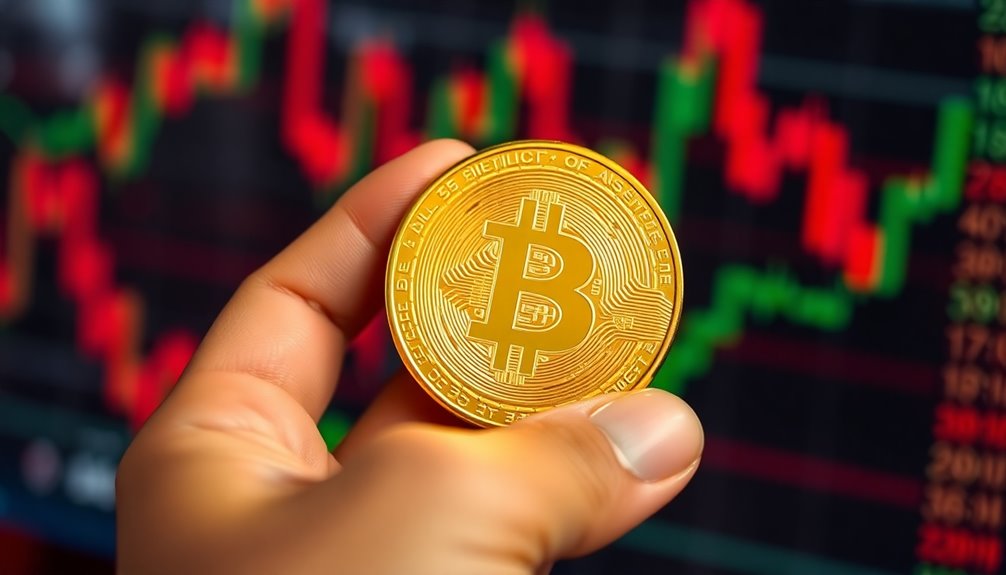ERC-20 is a crucial standard for creating and managing fungible tokens on the Ethereum blockchain. It defines six mandatory functions, like totalSupply and transfer, ensuring interoperability across decentralized applications (dApps) and wallets. With over 500,000 existing tokens, it's the leading framework for token development. The standard simplifies the process, making it easier for developers to create tokens efficiently. While it offers many advantages, such as enhanced interoperability, there are risks like security vulnerabilities and market volatility. If you want to uncover more about its significance and applications, there's plenty more to explore!
Key Takeaways
- ERC-20 is a standard for creating and managing fungible tokens on the Ethereum blockchain, proposed in 2017.
- It includes mandatory functions that ensure interoperability between tokens, dApps, and wallets.
- ERC-20 tokens are commonly used in Initial Coin Offerings (ICOs) to facilitate fundraising for projects.
- The standard simplifies token creation, allowing developers to easily deploy tokens with predefined rules.
- Market volatility significantly affects ERC-20 token investments, leading to rapid price fluctuations and risks.
Token Standard Overview

When diving into the world of cryptocurrency, understanding the ERC-20 token standard is crucial. This standard, proposed by Fabian Vogelsteller and formalized as Ethereum Improvement Proposal 20 in 2017, defines how fungible tokens can be created and managed on the Ethereum blockchain. ERC-20 tokens enable developers to create their own cryptocurrencies that can seamlessly interact with various applications and wallets within the Ethereum ecosystem. For those new to the space, grasping the crypto wallet basics for beginners is essential, as these wallets serve as the digital vaults for storing, sending, and receiving ERC-20 tokens. Understanding this standard empowers users and developers alike to take full advantage of the vibrant decentralized finance landscape.
It includes six mandatory functions, such as totalSupply and transfer, which facilitate interaction through smart contracts. By adhering to the ERC-20 standard, tokens ensure interoperability, allowing them to work seamlessly with various decentralized applications and wallets.
This compatibility enhances liquidity, making it easier for you to buy, sell, or trade tokens. With over 500,000 tokens currently in existence, the ERC-20 standard has become the dominant framework for token creation and has significantly impacted the cryptocurrency market.
ERC-20 Token Significance

The significance of the ERC-20 token standard in the cryptocurrency landscape can't be overstated. As the predominant framework for creating fungible tokens on Ethereum, it allows for the development of over 500,000 tokens.
This standard enhances interoperability among decentralized applications (dApps) and exchanges, making trading seamless. By simplifying token creation through predefined rules and smart contracts, ERC-20 reduces development complexity for developers.
It's also pivotal in the rise of Initial Coin Offerings (ICOs), streamlining fundraising for blockchain projects. Notable ERC-20 tokens, like Tether (USDT) and Chainlink (LINK), have bolstered decentralized finance (DeFi) by providing essential liquidity and utility, proving the standard's critical role in the evolving crypto ecosystem.
Token Creation and Management

Creating and managing tokens under the ERC-20 standard is straightforward, thanks to the clear guidelines and tools available. As a developer, you'll write smart contracts using the Solidity programming language, defining essential parameters like token name, symbol, totalSupply, and decimal units.
Platforms like OpenZeppelin offer secure templates, ensuring you follow best practices. Once deployed on the Ethereum blockchain, your token will require ETH for transaction fees, making it operational and tradable.
You'll implement mandatory functions such as totalSupply, balanceOf, transfer, and approve to facilitate token management and transfers.
Post-creation, your tokens can easily be traded across various decentralized applications (dApps) and exchanges, enhancing liquidity and accessibility for users.
Pros and Cons Summary

While ERC-20 tokens offer numerous advantages, they also come with notable drawbacks that you should consider.
These tokens enhance interoperability within the Ethereum ecosystem, enabling seamless integration and trading across diverse dApps and exchanges. The standardization of ERC-20 tokens simplifies the development process, making it easier to audit and maintain security through established best practices.
However, security vulnerabilities can emerge from poorly written smart contracts, making thorough audits crucial. Additionally, ERC-20 tokens experience scalability issues due to network congestion, which can lead to high gas fees and a frustrating user experience.
Finally, the sheer volume of ERC-20 tokens in the market can create confusion and increase the risk of scams or fraudulent projects, warranting caution in your investments. Furthermore, the rise of decentralized finance has increased interest in ERC-20 tokens, leading to more innovative use cases and potential market disruptions.
BEP-2 Token Differences

BEP-2 tokens and ERC-20 tokens cater to different blockchain ecosystems, each with its unique characteristics and functionalities.
ERC-20 operates on Ethereum, allowing seamless interoperability with various decentralized applications (dApps). In contrast, BEP-2 is a token standard used on the Binance Chain, primarily interacting within its ecosystem.
The token creation processes differ significantly; ERC-20 requires adherence to specific functions and events, while BEP-2 follows different protocols.
Market adoption also varies, as over 500,000 ERC-20 tokens exist, whereas BEP-2 tokens are fewer but gaining traction on the rising Binance platform.
Additionally, ERC-20 enjoys broad liquidity across numerous exchanges, while BEP-2 tokens are mainly traded on Binance and its affiliates, limiting their liquidity options.
Market Volatility Impacts Investments

Investing in ERC-20 tokens is heavily influenced by market volatility, which can lead to quick gains or losses. Rapid price fluctuations in popular tokens like Tether and Shiba Inu Coin illustrate the high liquidity available.
When Ethereum and other major cryptocurrencies swing, ERC-20 tokens often follow, amplifying your investment risks. During high volatility, you might find yourself caught in panic selling or FOMO, further destabilizing prices.
Regulatory changes and technological developments within the Ethereum ecosystem can also impact investor sentiment, shaping the overall performance of ERC-20 tokens.
Therefore, understanding market volatility is crucial for making informed decisions in your ERC-20 investments, as it directly affects your potential returns and risks.
Emerging Defi Applications Integration

As the decentralized finance (DeFi) landscape evolves, the integration of ERC-20 tokens has become increasingly vital for enhancing functionality across various platforms.
These tokens facilitate lending and borrowing, allowing you to access liquidity without relying on traditional banks. Popular DeFi platforms like Uniswap and Aave leverage ERC-20 tokens for automated trading and lending services, drawing in massive user participation.
The demand for tokenized assets is evident, with Uniswap surpassing $1 billion in liquidity in 2021. Governance tokens, often ERC-20 compliant, empower you to vote on protocol changes, promoting community-driven development.
Additionally, the rise of ERC-20 tokens has birthed innovative financial products, including synthetic assets and decentralized exchanges, expanding the Ethereum blockchain's capabilities and reach.
Utilize Gas Fee Calculators

When you're navigating the Ethereum blockchain, utilizing gas fee calculators can be a game-changer for managing transaction costs.
These tools estimate transaction fees for ERC20 tokens by considering the current gas price and the computational complexity of your transaction. By providing real-time data, gas fee calculators like EthGasStation and GasNow show you average, low, and high gas prices, helping you pick the best time to execute your transactions.
They also account for network congestion, which can drive gas prices up during peak hours. By timing your transactions effectively, you can significantly reduce transaction costs and save money.
Frequently Asked Questions
What Does ERC-20 Mean?
When you hear "ERC-20," it refers to a set of standards that define how tokens can be created and managed on the Ethereum blockchain.
It outlines essential functions like transferring tokens and checking balances. By following these standards, developers ensure their tokens can easily interact with various applications and wallets.
This compatibility has led to a thriving ecosystem, making it simpler for you to engage in transactions and participate in decentralized finance initiatives.
Is ERC-20 the Same as USDT?
No, ERC-20 isn't the same as USDT.
ERC-20 is a technical standard that defines how tokens can be created and managed on the Ethereum blockchain.
USDT, or Tether, is a specific cryptocurrency that follows the ERC-20 standard. It's designed to maintain a stable value by being pegged to the US dollar.
Is ERC-20 the Same as Ethereum?
No, ERC-20 isn't the same as Ethereum.
ERC-20 is a technical standard for creating fungible tokens on the Ethereum blockchain. Think of it as a guideline that ensures tokens can interact smoothly within the Ethereum ecosystem.
Ethereum, on the other hand, is the underlying platform that supports these tokens, along with decentralized applications and smart contracts.
What Is an Example of an ERC-20 Wallet?
Imagine holding a treasure chest filled with digital gold; that's what an ERC-20 wallet offers you.
An example is MetaMask, which lets you store, send, and manage your tokens right from your browser or mobile device.
Trust Wallet is another great option, providing a secure and user-friendly interface.
If you're looking for added security, consider hardware wallets like Ledger Nano S or X.
Each option ensures your assets remain safe and accessible.
Conclusion
In summary, understanding ERC-20 tokens is crucial for navigating today's crypto landscape. They're like the Swiss Army knife of digital assets, offering versatility and widespread use. While they come with their pros and cons, the potential for innovation—especially in DeFi—means there's never been a better time to dive in. Just remember to keep an eye on gas fees and market volatility. So, gear up and get ready to explore this exciting digital frontier!









